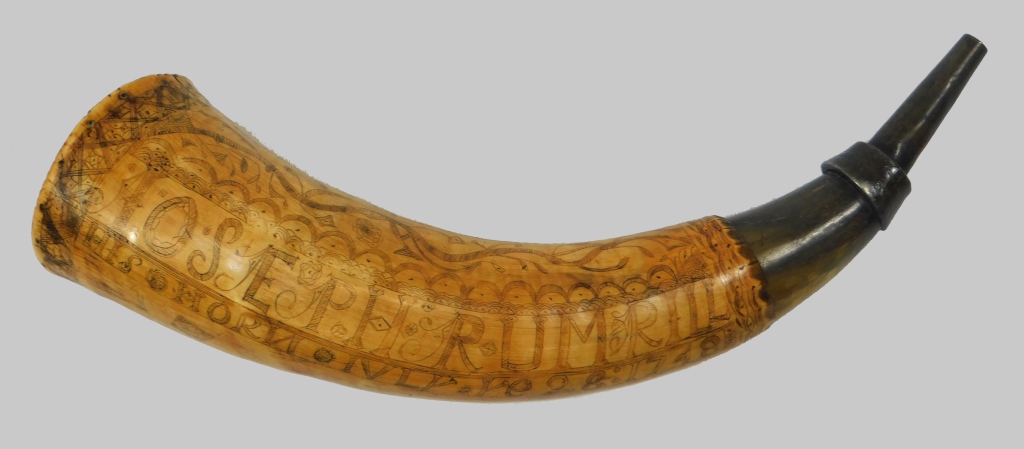Carved powder horns from the mid-to-late 18th century are wonderful pieces of early American folk art. From animals and ships to other scenes, they help tell the story of the era through simple and sometimes naïve carving. The best part for me is when there is a name and a date to research and find out more about the life of the original owner. I took in one such horn a few weeks ago.
As I had other things to do first, I placed the horn within eyesight and would pick it up from time-to-time to look at the carving and name. When I got the chance to sit down with it and do research, more information came to light.
It is a typical horn of the period, a cow horn that has been shaved and filed to shape and is made for someone who is right-handed. It is not typical in that it is made with a brass spout and a band to attach the spout made of lead. This could have been a period repair but it’s something I haven’t seen often. It has a typical pine plug fit into the base of the horn that is attached with tiny wooden pegs. The base has cross hatched lines with half circles, a crude ship with a flag and pennant, a snake, incised lines and foliate designs. Along the side it is marked “IOSEPH RUMRILL/HIS HORN IULY Ye 28: 1748.” The next step was to see what I could find out about him.
Joseph Rumrill was born in Chelmsford, Massachusetts about 1726. At some point he settled in Townsend, Massachusetts, a small town in northwest Middlesex County. As he was a male over the age of 16 it was his duty to join the militia. Tensions were running high with the French and their Native allies after King Georges War, and he enlisted in Captain Edward Hartwell’s company on August 9, 1748 to guard against enemy attacks. He served in Hartwell’s company until October 17, 1748 but his service did not end there. He was still serving in the militia and is listed as a member of Captain John Stevens foot company of Townsend and he received a bayonet for his gun on November 3, 1759.

Rumrill married Lucy Stevens on June 22, 1749 and started a family. On April 19, 1775 when the British marched to Concord to destroy Provincial stores sparking the American Revolution, he marched along with his 19-year-old son, Joseph jr., in Captain James Hosley’s company, Colonel William Prescott’s regiment. While they did not arrive in time for the fight that day, they did take part in the Siege of Boston.
He seems to have returned to Townsend after April 19 and resumed his life. He died on May 21, 1799 at the age of 73 and is buried in Townsend.
While the entire story is not complete, this carved horn gives us a glimpse into the life of a Colonial man. A husband, father, and his community life during this tumultuous period and the founding of a nation.




